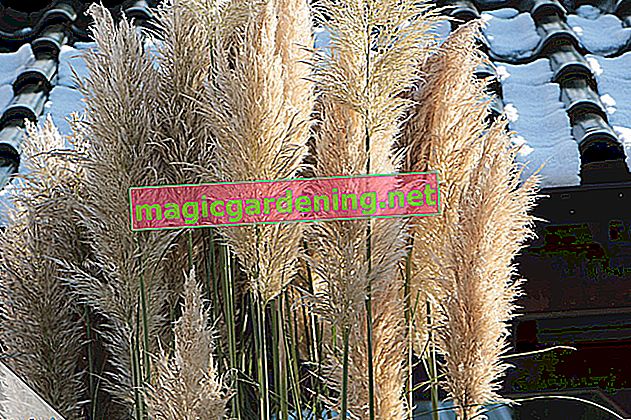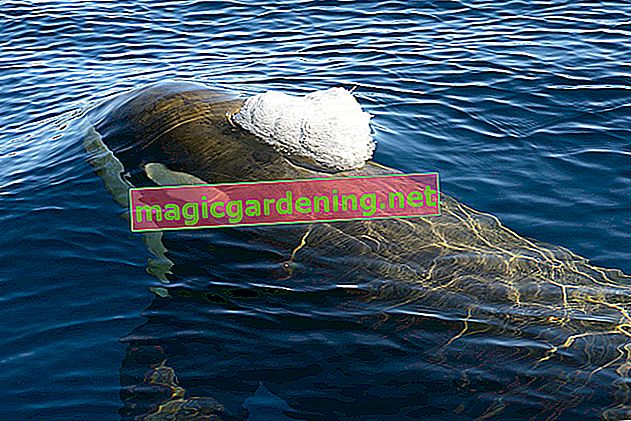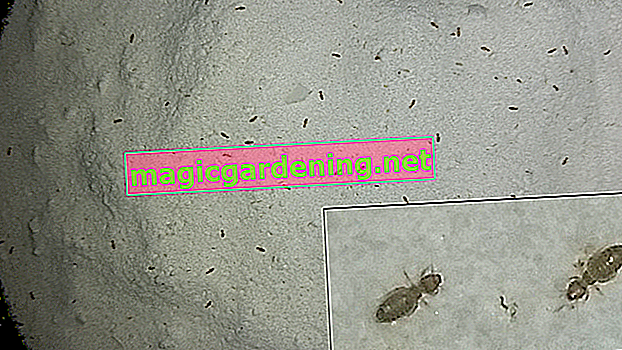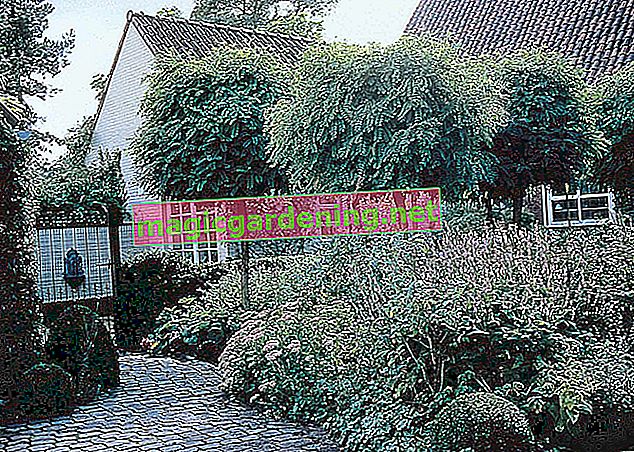
origin
Because of its name, one might be tempted to locate the zebra grass in its African origin. But if you keep in mind that it belongs to the species of Chinese help within the sweet grass family, it becomes clear that it originally comes from the Far East. This specific variety, botanically Miscanthus sinensis 'Zebrinus', was imported from Japan. Since it also knows four seasons and especially frosty winters in its original habitat, it gets along well in our Central European climate.
also read
- Plenty of sun - the ideal location for zebra grass
- Is zebra grass poisonous?
- Is zebra grass hardy?
growth
As a member of the Chinaschilfe, the zebra grass also shows a corresponding reed-like growth. It grows upright and bushy and forms quite dense clumps with short, horizontal rhizomes. In total, the zebra grass can grow up to two meters high. The stalks, which taper to a point at the top, do not branch, but sometimes fan out far outwards within the leaf tuff and hang over slightly, which makes for an imposing impression, especially at full height.
leaves
Not only the raised, wide-spread growth makes the zebra grass a very attractive front garden plant, but above all the appearance of the leaves themselves. With their long, narrow, lanceolate shape and the entire edges, they draw a very defined, clear contour, which makes the grass look almost chic. The eponymous horizontal stripes, which stand out in pale yellow from the fresh green background, are particularly eye-catching. However, this color only occurs during the vegetation phase over the summer. With the onset of autumn, the leaves take on a golden brown color.
blossom
The zebra grass rarely develops flowers in this country. And when they do, they appear late in the growing season, between August and October. They appear as silver-white, tomentose-haired panicles.
Location
The zebra grass prefers a sunny location, but can also do well in partial shade. You have a higher chance of a splendid formation of the pretty horizontal stripes if you plant it in a sunny spot. The zebra grass should also not be too cold and drafty. A southern location that is protected from strong winds is ideal.
To note:
- If possible sunny location, then also good formation of the stripes
- protected from harsh weather conditions
earth
You can easily plant the zebra grass outdoors permanently because of its hardiness to frost. But it can also be cultivated in the tub. In both cases it is important to offer it a relatively nutrient-rich, fresh and well-drained substrate. A soil with a certain amount of clay and sand is ideal, to which you add a good portion of humus when planting. Loosening up the grass with pebbles is good for its permeability.
Good drainage is also essential when cultivating in a tub.
How the earth substrate should be made:
- relatively nutritious, fresh and well drained
- Work in the drainage layer both in the field and in the bucket!
Planting time
The best time to plant the zebra grass is mid-spring from April.
Plant spacing
The planting distance to any neighboring plants and also between the individual young specimens is important. Because of its fast growing rhizomes and the pronounced clump formation, the zebra grass spreads quite intensively. If you want to prevent it from getting out of hand in the long run, you should consider installing a root barrier. The separation of overgrown eyrie foothills is also quite good with the spade, at least as long as the grass is not too old and tough.
The location is also an important factor in plant spacing. If you want the zebra grass to loosen up the structure in the perennial bed, a radius of at least one meter around the grass is recommended. In this case, the root barrier is particularly recommended.
In many cases, however, the zebra grass is also planted in a solitary position, for example in the front yard. It cuts a fine figure and can often take up more space. If you want to plant several specimens with a view to a small zebra grass forest, keep a planting distance of about four feet.
To note:
- Zebra grass tends to spread quite strongly - consider root barriers
- Prevent excessive expansion, especially in the bed, and keep a radius of about one meter
- if there are several specimens, plant a distance of about 1.20 m
to water
The zebra grass copes quite well with moderate dry phases, but it is a little more sensitive to moisture. If the ground is permanently wet, root rot can occur, which quickly kills the zebra grass. When planting outdoors, it is therefore important to incorporate effective drainage, especially if the soil is rather compact in the area. If the summer is dry and hot for a long time, you should water the plant regularly.
When cultivating in the bucket, watering is necessary closer together, especially in summer. Water regularly so that the root ball does not dry out. Waterlogging is, of course, particularly to be avoided in bucket culture. So make sure that you empty the planter after rainy days.
Overview of water requirements:
- needs a moderate amount of water
- Water regularly in longer dry phases
- Avoid waterlogging at all costs
Fertilize
Apart from a humus-rich plant substrate and a little compost in the spring, you don't need to fertilize the zebra grass very well.
To cut
In general, it is advisable to prune the zebra grass once a year. This promotes a fresh new shoot and a magnificent development in the growing season. You can also cut the stalks close to the ground, which gives the grass an effective kick of freshness.
However, you should only carry out the pruning in spring. Firstly, the plant's foliage material offers good protection from overly harsh weather over the winter. You can increase this protective effect by tying the stalks together at the top, making the zebra grass more compact and more resistant to cold and wind. Second, the stalks can be quite decorative even in winter weather.
The ideal time to remove the old leaves is when the new ones dare to emerge from the earth as small, bright shoots. Now they need light and should be freed from the stalks of the previous year. Of course, make sure that you do not damage the young shoots when cutting.
It is best to use large, sharp hedge trimmers for pruning. (€ 135.56 at Amazon *)
Overview of pruning rules:
- Complete pruning close to the ground once a year
- Let old leaves stand over the winter to protect the plant, possibly tie them together
- Cut back as soon as the new leaf shoots appear
balcony
A zebra grass can also be kept well in the bucket - this benefits those grass fans who do not have a garden. In the bucket you have to look after the zebra grass a little more carefully due to the limited planting ground, but the care is also quite uncomplicated here.
The maintenance of the planting ground consists primarily of regular watering to avoid waterlogging, especially on hot, dry days. A lot of heat can then accumulate on the balcony and a lot more water can evaporate due to the many close walls. You should provide the substrate with a good drainage layer to ensure that it drains off well. You can fertilize the zebra grass by adding some compost in the spring.
The advantage of bucket culture is that there is no risk of excessive spreading. The pot automatically acts as a root barrier and prevents the grass from forming excessive clumps. However, the zebra grass needs to be repotted every now and then if the pot is too tight.
A location on the balcony is often very suitable for a zebra grass in the bucket. Because here it is usually well protected from sharp winds. But because the zebra grass would like to be in the sun, the balcony should face south or south-west if possible. Wintering is usually not a problem, the zebra grass itself is resistant to temperatures down to -20 ° C. In very severe frost, however, you should wrap the pot in sackcloth as a precaution.
Overwinter
In the wild, the frost-hard zebra grass is as good as safe from freezing, as it can withstand double-digit minus temperatures. However, it is advisable to protect the plant heart a little by leaving the old leaves to stand through the winter. You can also tie them together to make the plant more compact and wind resistant.
The root ball of the zebra grass is somewhat more sensitive in bucket culture. If the frost is very severe, you should therefore wrap the pot with raffia or sackcloth. Proceed with the foliage in the same way as with the cultivation in the field. It is also not wrong to put the bucket under a roof to protect against wind and weather.
Multiply
division
The propagation of clump-forming grasses is basically simple and best possible by dividing the root ball. Since the zebra grass forms a very dense network of rhizomes, you can easily cut something off with a sharp spade. Every now and then the department of expanding clumps in the field is necessary anyway - then you can use the opportunity to get yourself or interested gardener friends an offshoot.
Propagate is best done in spring. When dividing, make sure that the separator has some well-formed stalks with healthy roots. Put it where you want it and water it well.
With advanced age and increasing hornification, the zebra grass can become bald in the middle, which of course is detrimental to its appearance. To get a nice bushy, attractive plant again, dig up all the grass and the root ball and divide it up. To replant, take a piece from the outer, younger area. You put it back in its original position.
Seed cultivation
Seed cultivation is of course also possible in principle, but not as easy as sharing. In addition, if you use your own harvested seeds, non-varietal specimens without the characteristic stripes can arise. You hardly get your own seeds anyway because of the rare bloom. However, there are some offers in specialist shops.
Put the seeds in bowls with potting soil and cover them only lightly. The seeds need room temperature and uniform humidity to germinate. It is recommended to pull them under foil until germination.
Diseases
Fortunately, the zebra grass is very resistant to diseases. As long as you protect it from excessive drought and waterlogging, it shouldn't cause you any problems. If the dryness is too long and the sunlight is too intense, the leaves can dry out. But don't forget: the brown color in autumn is normal and not a cause for concern!
Zebra grass is also hardly affected by pests. Miscanthus mealybugs may appear.
tip
You can use the ornamental value of zebra grass in many ways. The solitary position in the front yard is a very popular and recommended variant. But the beautiful reeds also look great at the edges of the pond. Here, however, you have to make sure that you plant it with sufficient distance to the permanently wet pond floor. The striped stalks of the zebra grass are also very decorative as clippings in bouquets.
sorts
Not only the right zebra grass is a very nice eye-catcher in the garden. Other Chinese silver sorts also have very attractive appearances and are no less easy to cultivate.
Miscanthus sinensis 'Strictus'
This variety is extremely similar to Miscanthus sinensis 'Zebrinus' and is usually also referred to simply as zebra grass. It has a somewhat more upright, tighter growth and also somewhat more linear leaves than the real zebra grass, but shows the same decorative stripe color in fresh green and bamboo yellow. In height it reaches about 1.30 to 1.50 meters. The flowers appear as brownish panicles late in the season in September or October, if at all.
Miscanthus sinensis 'Far East'
This Chinese silver grass variety is also an interesting alternative to zebra grass. Although it lacks the stripes on the leaves, it also offers a distinctive color appeal with its reddish autumn color. In addition, the variety forms particularly large, structurally filigree spike flowers in September or October, which first appear in a reddish brown tone and later turn into a beautiful silver white. They also look particularly beautiful when their faded heads are covered with hoarfrost in winter.
The deciduous leaves are very narrow, tapering to a point and form a long, arched tuft. Overall, the 'Far East' variety is as high as the zebra grass, up to 1.60 meters.
Miscanthus sinensis 'Malepartus'
The 'Malepartus' variety is also a very beautiful and impressive Chinese reed. It is characterized by a growth of up to 2 meters with elegant overhanging stalks that have a fresh green color with a white center line. In terms of shape, the stalks are relatively broad, tapered and have entire edges. In autumn, the foliage turns reddish, similar to the 'Far East' variety, but less brownish here, but more radiant.
The flowers of this variety are also extremely decorative: from August onwards they appear as very large, flag-like panicles in a reddish, later silvery white color.
 Zebra grass 5.38 EUR Buy at baldur
Zebra grass 5.38 EUR Buy at baldur  MY BEAUTIFUL GARDEN grass bed 'Sun' 44.1 EUR Buy at baldur
MY BEAUTIFUL GARDEN grass bed 'Sun' 44.1 EUR Buy at baldur  Winter hard grass bed 31.4 EUR Buy at baldur
Winter hard grass bed 31.4 EUR Buy at baldur








